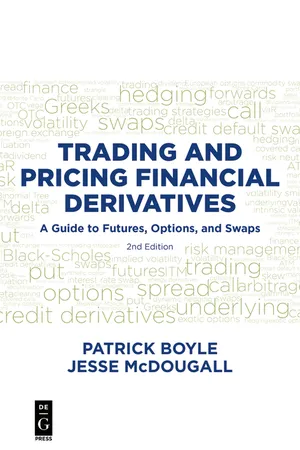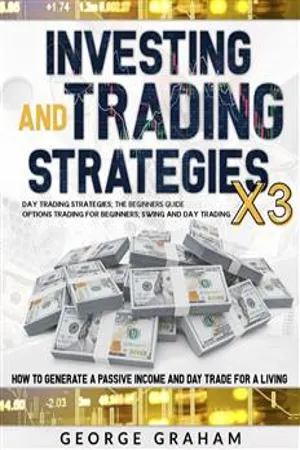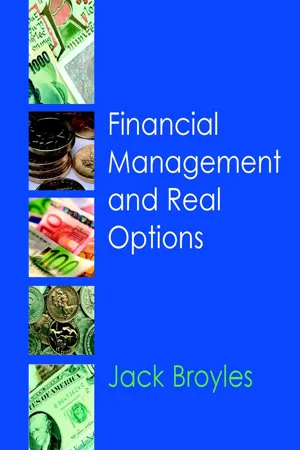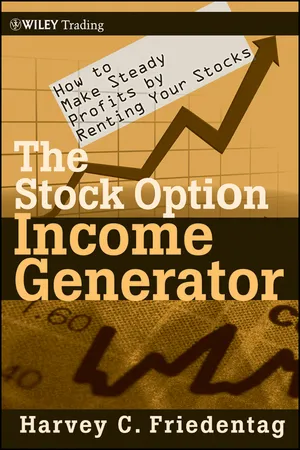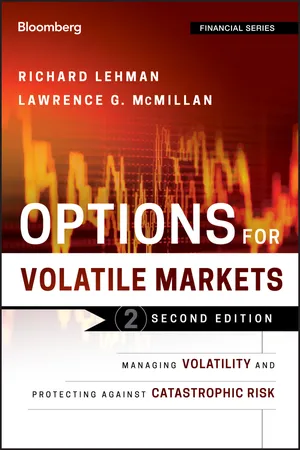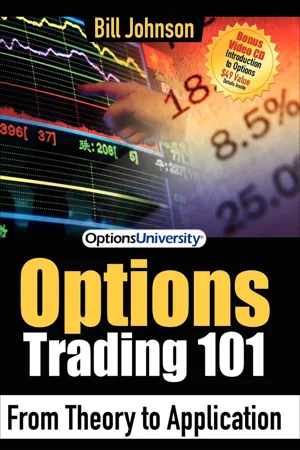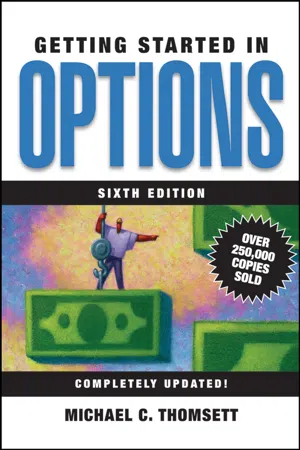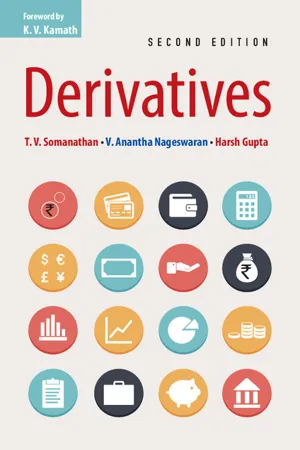Business
Options
Options in business refer to the right, but not the obligation, to buy or sell an asset at a specified price within a set timeframe. They are commonly used for hedging against price fluctuations, speculating on market movements, or as a form of employee compensation. Options can be valuable tools for managing risk and creating strategic investment opportunities.
Written by Perlego with AI-assistance
Related key terms
1 of 5
12 Key excerpts on "Options"
- eBook - ePub
The Options Edge
An Intuitive Approach to Generating Consistent Profits for the Novice to the Experienced Practitioner
- Michael C. Khouw, Mark W. Guthner(Authors)
- 2016(Publication Date)
- Wiley(Publisher)
Chapter 1 What Is an Option, and How Do Options Work?An option is a contract to buy or sell any specific item, which is referred to as the underlying instrument, asset, or interest. As with all contracts, there are two parties involved. An option contract is an agreement that gives the buyer or owner of the contract the opportunity, but not an obligation, to buy or sell the underlying instrument at their discretion. The seller, on the other hand, has the obligation to perform the seller's end of the bargain should the buyer choose to exercise their right to transact under the terms of the agreement.The underlying instrument is commonly a financial instrument like a stock, an index of financial instruments, a basket of stocks such as an ETF, a bond or a currency. The underlying instrument does not have to be a financial instrument, however. An option may reference a physical good such as a commodity (oil, gas, gold, silver or copper) or an economic good such as electricity, water, or real estate, and so on. Since investors are interested in Options as a means of pursuing certain financial and/or risk management objectives in their investment portfolios, this book will focus on Options referencing financial assets, such as stocks and stock indexes. Rest assured that the principles underlying an option contract are universal. It is easy to take the concepts presented and apply them to other aspects of your economic life, be it the purchase or sale of real estate or the management of a business.The terms and conditions of an option contract must be very precise. The contract defines when, how, and at what price the contract will be executed. For Options on financial assets, there are a number of standard terms the buyer and seller must agree upon. Fortunately, Options listed on exchanges have standardized terms. This makes financial Options liquid and easy to trade. Once you know the basic standardized terms of an option contract, you are good to go. Firstly, an option contract will establish the price of a trade, if a transaction were to occur. A transaction only occurs, if and only if, the owner of the option choses to exercise their right to transact. When an owner of an option exercises their right to transact, they make the demand that the seller of the option perform to the terms and conditions of the option contract. When a contract is exercised, the obligation is fulfilled and the contract is terminated. The price at which a trade occurs is known as the strike price. The contract multiplier defines the amount of stock or commodity transacted under the option agreement. For Options on equities, the contract multiplier is typically 100. This means that a single option contract references 100 shares of stock. As a result, when the owner of a call option on a stock exercises their right, the option seller must deliver 100 shares of stock. Options do not last forever. The contract will define the length of time an option will remain effective. Should the buyer choose to exercise their right under the option agreement and transact, the buyer must do so within this window of time. The date upon which an option expires is known as the expiration date - eBook - ePub
Trading and Pricing Financial Derivatives
A Guide to Futures, Options, and Swaps
- Patrick Boyle, Jesse McDougall(Authors)
- 2018(Publication Date)
- De|G Press(Publisher)
Chapter 3Introduction to Options
What Is an Option?
An option is a derivative financial instrument that specifies a contract between two parties for a future transaction on an asset at a reference price. The buyer of the option gains the right, but not the obligation, to engage in that transaction, while the seller incurs the corresponding obligation to fulfill the transaction. Options cost money to buy at inception while futures cost nothing to enter into, either as a buyer or as a seller, at inception.There are two basic types of option: calls and puts.Options Contract Specifications
Each financial option is a contract between two counterparties with the terms of the option specified in a term sheet. Some exotic Options may have extremely complicated term sheets, but all contracts usually contain the following specifications:–A description of what the underlying asset is –Whether the option holder has the right to buy or the right to sell the underlying –The quantity and quality, or class, of the underlying asset –The “strike price,” which is the price at which the transaction will occur upon exercise –The expiration date, which is the last date the option can be exercised –Whether the writer must deliver the actual asset on exercise, or may simply tender the equivalent cash amountCall Option
The buyer of a call option has the right, but not the obligation, to buy agreed lots of 100 shares of the option by the expiration, for a certain price: the strike price. The seller (or “writer”) is obligated to sell the commodity or financial instrument should the buyer so decide.The buyer pays a fee, called a premium , for this right.Put Option
The buyer of a put option - eBook - ePub
- Joel Priolon(Author)
- 2018(Publication Date)
- Wiley-ISTE(Publisher)
5 Options MarketsOptions have seen considerable growth since the 1970s and, today, are among the most widely exchanged financial contracts on markets around the world. The basic principles on which Options are based are easy to understand. However, the pricing of Options is a difficult exercise based on an advanced mathematical corpus. This is why certain technical developments related to this are dicsussed in the Appendix.5.1. The fundamental conceptsAn option is a financial contract that binds the issuer, or writer of the option and the holder of the option, who has acquired the buying rights (option to buy) or the selling rights (option to sell) for certain goods, at a certain date (or over a certain period), at a price fixed in advance. In other words, the holder of an option has the right to buy or sell but has no obligation to exercise this right. When the contract is created, the option writer receives a premium paid by their acquirer. At the time when they commit to an Options contract, the role of the seller and the buyer are unambiguous; but, going forward, the buyer may cede their option without, however, becoming the writer. This is why, in the rest of this chapter and in order to remove certain ambiguities, we will talk of “the writer” and not of the “seller”. Similarly, we will talk of the “holder of the option”, rather than “the buyer”. However, the reader must be aware that in other essays and books, these operators are very often called simply “seller” or “buyer”.
The vocabulary used when talking about Options is quite particular. We have provided, below, a list of the most frequently used terms:5.1.1. Characteristics of Options and a glossary- – call
- eBook - ePub
Investing and trading strategies X3
Day Trading Strategies, Options Trading for Beginners, Swing and Day Trading
- George Graham(Author)
- 2023(Publication Date)
- Youcanprint(Publisher)
CHAPTER 1:What is Options Trading?- What Are Options?
An option is a contract that gives the holder the right to sell or buy an asset at a set price (the strike price) within a given period (the term) but does not obligate the holder into doing so. The strike price may be lower or higher than the current asset price (market price).Like a bond or stock, an option is a tradable security. You can purchase or sell Options to a foreign broker or trade them on an exchange within the United States. An option may give you the opportunity to leverage your cash, though it may be high risk because it eventually expires(expiration date). For stock Options, each option contract represents 100 shares.- The Options Trading Concept
An instance of an option is if you want to buy a car/house, but for whatever reason, do not have immediate cash for it but will get the money next month. The item owner may agree to give you the option to purchase the house in a month for, let us say $250,000 if you pay $2,500 now for the option. Near the expiration of your option, the asset’s value may appreciate perhaps because of the discovery that the house is on a highly valued piece of land.You can now buy the asset at the agreed price and sell it for a profit. The asset's value may also depreciate perhaps when the house develops plumbing problems or other problems or, in the case of a vehicle, gets into an accident. If you decide not to buy the asset and let your purchase option expire, you lose your initial investment, the $2,500 you placed for the option.This is the general concept of how Options trading happens; however, in reality, Options trading is a lot more complex and involves more risks.- Basic Option Trading Terminologies
- eBook - PDF
- Jack Broyles(Author)
- 2003(Publication Date)
- Wiley(Publisher)
Option Contract granting the right without obligation to engage in a future transaction on terms specified in the contract. Partnership Contractual business relationship between two or more people who share in the risks and profits of the business. Each partner has unlimited liability for the actions and debts incurred by the other partners. Put option Option giving the holder the right without obligation to sell the option’s underlying asset at a specified price on or before a specified date. 3-4 EXECUTIVE STOCK Options Options play a prominent role in finance. Executive stock Options are especially important. Executive stock Options represent a type of bonus for managers. The purpose of these Options is to 52 INTRODUCTION TO FINANCIAL MANAGEMENT 7 For example, an American call option is a financial contract permitting the option holder the right, but not the obligation, to buy a given number of a company’s shares at a specified price before a specified future date. An American put option is a financial contract permitting the option holder the right, but not the obligation, to sell a given number of a company’s shares at a specified price before a specified future date. reward managers when their actions increase the company’s share price, thereby benefiting share- holders. EXAMPLE 3.6 For example, a company’s share price currently stands at C ¼ 1.00. The board of the company grants executive stock Options to the senior and middle-ranking managers, giving each of them the right to buy 1,000,000 shares from the company for C ¼ 1.50 per share. The Options are eligible for exercise after five years by managers still employed by the company. The incentive for these managers is obvious. If they pursue activities that increase the share- holders’ equity, and after five years the share price increases to C ¼ 2.50, exercising the executive option would be worth 2:50 – 1:50 = 1:00 per share. The resulting payoff on 1,000,000 shares would be C ¼ 1 million for each manager. - eBook - ePub
The Stock Option Income Generator
How To Make Steady Profits by Renting Your Stocks
- Harvey C. Friedentag(Author)
- 2009(Publication Date)
- Wiley(Publisher)
CHAPTER 12Options and the Stock MarketMoney is like a sixth sense without which you cannot make a complete use of the other five.—W. Somerset MaughamYou are now ready to be introduced to the real world of the stock market. A stock can do three things: it can go up, it can go down, or it can stay the same in value. Regardless of what the stock value does, it can be to your advantage. You will learn how to deal with this volatility and make money.The brokerage industry has finally come up with a wonder weapon: Exchange listed Options.WHAT IS AN OPTION?
According to Webster’s New World Dictionary, option is defined as “1. to wish, desire. 2. . . . choosing; choice. 3. the power, right, or liberty of choosing. 4. the right, acquired for a consideration, to buy or sell . . . something at a fixed price . . . within a specified time.” The last definition applies to Options in the stock market.The following material is an introduction to the use of Options as an investment tool. The material is divided into two sections. The first section describes the basic terminology of Options, factors affecting option prices, and the ways Options are bought and sold. The second section describes why an investor would buy or sell an option. It also deals with the basic concepts of Options and how and why an investor would use them.THE BUSINESS OF Options
Options of one kind or another are commonplace in the business world, such as the option to purchase real estate. The essential components of a securities option are: a description of the security the option buyer may purchase from, or sell to, the option writer; the price at which the security may be purchased or sold; and the time period during which the buyer of the option must exercise or lose his or her right. If the option buyer chooses not to exercise his or her right during the allocated time, the option simply expires. It ceases to exist. - eBook - ePub
Options for Volatile Markets
Managing Volatility and Protecting Against Catastrophic Risk
- Richard Lehman, Lawrence G. McMillan(Authors)
- 2011(Publication Date)
- Bloomberg Press(Publisher)
Chapter 1 Option BasicsTo understand and implement option strategies effectively, you need to understand not only how stocks and the equity markets work, but what Options are, how they function, and what affects their value. The strategy discussions in this book assume you are already familiar with stocks and Options, so to refresh you on the basics, we have constructed Chapters 1 and 2 as a review of listed equity Options. If you are already familiar with Options, you can begin reading about call writing in Chapter 3.What Are Options?An option is a contract representing the right, for a specified term, to buy or sell a specified security at a specified price. Like stock, they are also standardized so they can trade on formal securities exchanges and are regulated by the Securities and Exchange Commission (SEC).There are two types of Options: puts and calls.1. Call option: A contract representing the right for a specified term to buy a specified security at a specified price.2. Put option: A contract representing the right for a specified time to sell a specified security at a specified price.The specified price is known as the strike, or exercise, price; the specified term is determined by the option's expiration date; and the specified security is referred to as the underlying security. There are exchange-listed Options on a number of securities and even non-securities (such as indexes), but this book is devoted entirely to those on stocks and exchange-traded funds (ETFs).We may refer to both of these in aggregate as equity Options. - eBook - ePub
Options Trading 101
From Theory to Application
- Bill Johnson(Author)
- 2020(Publication Date)
- Morgan James Publishing(Publisher)
Chapter One
Introduction to Options
What Is an Option?
Options are simply legally binding agreements – contracts – between two people to buy and sell stock at a fixed price over a given time period.There are two types of Options: calls and puts . A call option gives the owner the right, not the obligation, to buy stock at a specific price over a given period of time. In other words, it gives you the right to “call” the stock away from another person. A put option, on the other hand, gives the owner the right, not the obligation, to sell stock at a specific price through an expiration date. It gives you the right to “put” the stock back to the owner. Option buyers have rights to either buy stock (with a call) or sell stock (with a put). That means it is the owner’s choice, or option , to do so, and that’s where these assets get their name.Now you’re probably thinking that this is sounding complicated already. But Options are used under different names every day by different industries. For instance, we are willing to bet that you’ve used something very similar to a call option before. Take a look at the following coupon:The way pizza coupons and call Options work is very similar. This pizza coupon gives the holder the right to buy one pizza. It is not an obligation. If you are in possession of this coupon, you are not required to use it. It only represents a right to buy. There is also a fixed price of $10.00. No matter how high the price of pizzas may rise, your purchase price is locked at $10.00 if you should decide to use it. Last, there is a fixed time period, or expiration date , for which the coupon is good.Now let’s go back to our definition of a call option and recall that it represents:1) Right to buy stock2) At a fixed price 3) Over a given time period You can see the similarities between a call option and pizza coupon. If you understand how a simple pizza coupon works, you can understand how call Options work. - eBook - PDF
- Michael C. Thomsett(Author)
- 2007(Publication Date)
- Wiley(Publisher)
These are some of the features of Options. Taken alone (and out of context), these attributes certainly do not make this market seem very appealing. These attributes—lack of tangible value, worthlessness in the short term, and decline in value itself—make Options seem far too risky for most people. But there are good reasons for you to read on. Not all methods of investing in Options are as risky as they might seem; some are quite conservative, because the features just 8 GETTING STARTED IN Options mentioned can work to your advantage. In whatever way you might use Options, the many strategies that can be applied make Options one of the more interesting avenues for investors. The more you study Options, the more you realize that they are flexible; they can be used in numerous situations and to create numerous opportunities; and, most intriguing of all, they can be either exceptionally risky or downright conservative. Smart Investor Tip Option strategies range from high-risk to extremely conservative. The risk features on one end of the spectrum work to your advantage on the other. Options provide you with a rich variety of choices. option the right to buy or to sell 100 shares of stock at a specified, fixed price and by a specified date in the future. An option is a contract that provides you with the right to execute a stock transaction—that is, to buy or sell 100 shares of stock. (Each option always refers to a 100-share unit.) This right includes a specific stock and a specific fixed price per share that remains fixed until a specific date in the future. When you have an open option position, you do not have any equity in the stock, and neither do you have any debt position. You have only a contractual right to buy or to sell 100 shares of the stock at the fixed price. - eBook - PDF
Fundamentals of Financial Instruments
An Introduction to Stocks, Bonds, Foreign Exchange, and Derivatives
- Sunil K. Parameswaran(Author)
- 2022(Publication Date)
- Wiley(Publisher)
CHAPTER 7 Options Contracts INTRODUCTION Forward and futures contracts, which we examined earlier, are commitment con-tracts. That is, once an agreement is reached to transact at a future point in time, noncompliance by either party would be tantamount to default. In other words, hav-ing committed to the transaction, the long – whom we have defined as the party who has agreed to acquire the underlying asset – must buy the asset by paying the pre-fixed price to the short. At the same time, the short is obliged to deliver the underlying asset in return for the payment. Now let us turn our attention to contracts that give the buyer the right to transact in the underlying asset. The difference between a right and an obligation is that a right needs to be exercised if it is in the interest of holders and need not be exercised if it is not beneficial for them. An obligation, on the other hand, mandates them to take the required action, irrespective of whether they stand to benefit or not. Contracts to transact at a future point in time, which give buyers the right to transact, are referred to as Options contracts, for they are being conferred an option to perform. When it comes to bestowing a right, there are two possibilities. Buyers can be given the right to acquire the underlying asset or they can be given the right to sell the underlying asset. Consequently, there are two categories of Options: call Options and put Options. A call option gives the buyers of the option the right to buy the underlying asset at a predecided price, whereas a put option gives them the right to sell the underlying asset at a pre-fixed price. The prespecified price in the contract is termed as the strike price or the exercise price. Let us first consider call Options. Clearly, holders will exercise their right to pur-chase the underlying asset only if the prevailing spot price at the time of exercise is higher than the exercise price. - eBook - PDF
- Michael C. Thomsett(Author)
- 2005(Publication Date)
- Wiley(Publisher)
But there are good reasons for you to read on. Not all methods of investing in op- tions are as risky as they might seem; some are quite conservative, because the features just mentioned can work to your advantage. In whatever way you might use Options, the many strategies that can be applied make Options one of the more interesting avenues for investors. The more you study Options, the more you realize that they are flexible; they can be used in numerous situations and to create numerous opportunities; and, most intriguing of all, they can be either exceptionally risky or downright conservative. An option is a contract that provides you with the right to execute a stock transaction—that is, to buy or sell 100 shares of stock. (Each option always refers to a 100-share unit.) This right includes a specific stock and a specific fixed price per share that remains fixed until a specific date in the future. When you have an open op- tion position, you do not have any equity in the stock, Calls and Puts: Defining the Field of Play 5 Option strategies range from high-risk to extremely conservative. The risk features on one end of the spectrum work to your advantage on the other. Options provide you with a rich variety of choices. Smart Investor Tip option the right to buy or to sell 100 shares of stock at a spec- ified, fixed price and by a specified date in the future. and neither do you have any debt position. You have only a contractual right to buy or to sell 100 shares of the stock at the fixed price. Since you can always buy or sell 100 shares at the current market price, you might ask: “Why do I need to purchase an option to gain that right?” The answer is that the option fixes the price of stock, and this is the key to an op- tion’s value. Stock prices may rise or fall, at times significantly. Price movement of the stock is unpredictable, which makes stock market investing interesting and also defines the risk to the market itself. - eBook - PDF
- T. V. Somanathan, V. Anantha Nageswaran, Harsh Gupta(Authors)
- 2017(Publication Date)
- Cambridge University Press(Publisher)
An Options contract is therefore one sided or unilateral and the purchaser has more rights than the seller of the option. However, in order to acquire this right the option buyer has to pay a premium to the option seller, which is not required in a futures contract. Options are conceptually very similar to insurance contracts where a fixed premium is paid in return for cover against adverse risks. (The key differences between an option and an insurance contract are the absence of need for an ‘insurable interest’ and the fact that Options can be used to earn profits and not just to protect against an eventual loss, as in insurance contracts.) From the buyer’s viewpoint, an option has a certain and limited loss (the amount of premium) with unlimited profit potential. From the point of view of Options sellers, an option has a certain and limited profit potential with virtually unlimited loss potential. 1 A futures contract has an unlimited loss and profit potential for both parties. Earlier we saw that futures and forward contracts could be used as hedges. Options can also be used as hedges. Hedging through Options has different payoffs (i.e., profit/ loss outcomes) as compared to hedging with futures or forwards, or ‘linear’ derivatives in general. 2 A farmer hedging his crops by selling futures ‘locks in’ the future price. While he is protected against price falls, he also misses out on any increase in prices. The same farmer can have protection as well as keep the ‘upside’ (i.e., profit potential) by buying a put option. If, for the purposes of simplicity, we assume that a farmer buys an ATM European put (that is, where the current price is equal to the strike price 3 ), then any decrease in prices is compensated for by the increasing value of the put option. On the other hand, any increase in prices is welcome and only the premium is lost. An option is thus a one-sided hedge. Table 10.2 makes a comparison between futures and Options as hedging instruments.
Index pages curate the most relevant extracts from our library of academic textbooks. They’ve been created using an in-house natural language model (NLM), each adding context and meaning to key research topics.

